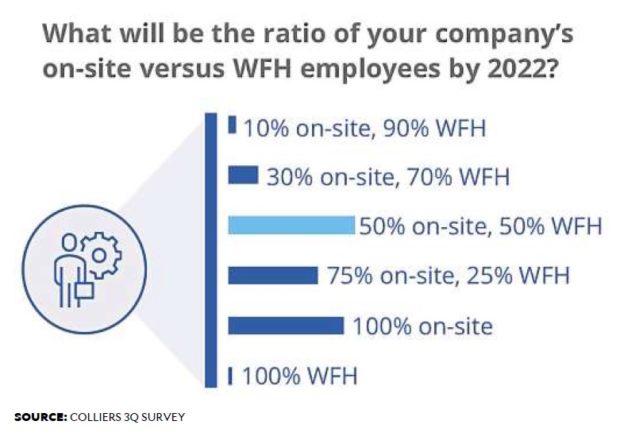PH firms transitioning to hybrid work setups in 2022

INQUIRER.net Stock Photo
MANILA, Philippines — Two years into the pandemic, Nicholas Mapa, an economist at Dutch bank ING, is raring to go out again — work in his office some days but work from home on other days — and meet friends once in a while.
“I’m ready to go. It’s been too long,” Mapa says, adding, however, that he will do so only if the COVID-19 virus remains under control.
Even before the COVID-19 pandemic struck, ING had been pilot-testing a hybrid work arrangement, whereby employees were allowed to work in the office four days a week and work remotely once a week.
“So when the pandemic hit, we were actually pretty much set up for this—to do work from home. I think now that everybody has experienced it, they’re likely to say ‘kaya naman pala e’ (it’s doable),” he says. “It does help companies save on cost to some extent. I think it also helps increase enthusiasm, because you’re not very often boxed in your offices.”
The decline in daily new cases has encouraged the government to ease mobility restrictions and as quarantine protocols are further relaxed, ING is planning to institutionalize a hybrid workplace model, giving its employees the option to work either in the office or at home.
Such a hybrid model works for Mapa. “It’s still different working from here or working in the office. But we will be given that option to mix,” he says at an online economic briefing conducted from his home, as he has done so multiple times for clients and the media since the pandemic reached the Philippines in March 2020.
“I prefer [the] hybrid setup—getting the chance to go out and see some friends again, but also staying safe, and then trying to prevent the spread of the virus,” he says. “ I think other companies pick up on that as well.”
Many businesses that have enabled work-from-home (WFH) arrangements during this pandemic are likewise preparing to shift to hybrid work arrangements, especially for the segments in their business that can operate remotely. Even the business process outsourcing (BPO) companies have been allowed to have 90 percent of their staff under WFH arrangements and still retain their fiscal incentives during this pandemic, although it remains to be seen how long they will be allowed by the government to keep this arrangement.
There are those who do not have such options, like health-care workers, police authorities as well as staff of groceries, factories, utilities, hotels, and bank branches who need to be in the field. They are the front-liners during this pandemic.
This is why some CEOs choose to come to the office, even if they have the ability to manage their organizations remotely.
Even at the height of the pandemic, Bank of the Philippine Islands CEO Teodoro Limcaoco chose to go to the office every day. He would even pay branches surprise visits.
“When we ask our front-liners—tellers, branch people to come every day, how can I not come every day?” he quips.
Back to on-site work
During its third quarter Metro Manila property market briefing, which had mostly property developers, analysts and businessmen in the audience, property consulting firm Colliers reports that with increased confidence in the COVID-19 vaccines, employers are expecting more of their employees on-site by 2022. (See chart.)About 34 percent of the respondents of Colliers’ third quarter survey expect at least half of their workforce to return to their offices starting 2022. “This signifies that occupiers are still considering a hybrid working model including a mix of work-from-home and on-site operations,” Colliers says in a Nov. 29 research note.
Meanwhile, 31 percent of the respondents expect their employees to fully work on-site in 2022.
“In our view, any rebound in office leasing will be supported by the successful COVID inoculation which should allow more employees to report back to their offices. Despite the implementation of work-from-home arrangements, some firms, including outsourcing companies, continue to look for office space across the country. We see these leasing queries materializing over the next 12 months and resulting in greater office space takeup,” Colliers opines.
More than 70 percent of Colliers’ respondents say that 81 to 100 percent of their employees have already been vaccinated against COVID-19.
Colliers recommends that office occupiers finalize their split-operations plans and prepare for employees to return to the office.
WFH not for everyone
Newly listed real estate investment trust Filinvest REIT Corp. (FILRT) expects a growing number of IT and BPO firms resuming on-site operations as COVID-19 cases decline and many Filipinos get vaccinated.
“While WFH is an option, it is not for everyone, especially for multinational BPO companies,” says Maricel Brion-Lirio, president of FILRT, which is the leading office space provider in Alabang, with a market share of close to 50 percent.
Brion-Lirio says FILRT’s tenants, including those that belong to the top 10 BPO companies in the world, prefer the office setup due to concerns about potential security data breaches, poor internet connectivity, and low productivity due to numerous distractions when employees are in a WFH mode.
“A majority of the multinational locators said prolonged lack of face-to-face interaction, social isolation and reduced camaraderie among employees pose a threat to mental health,” she adds.
Property consulting firm KMC Savills estimates that 98,000 square meters (sqm) of office space have been taken up in the third quarter, bringing to 325,000 sqm the office takeup year-to-date. Excluding lease preterminations, net market absorption stands at just 147,000 sqm — but this marks a turnaround from the net negative absorption of 164,000 sqm in 2020.
BPO firms account for most of the new leases while expanding e-commerce firms add to the demand. Philippine Economic Zone Authority (Peza)-accredited buildings capture 71 percent of demand.
“Despite Peza allowing work-from-home for accredited companies—until, of course, a policy review after the first quarter of 2022—this did not stop some IT-BPM (IT-business process management) companies to secure Peza spaces. This is potentially due to the nature of the services and the contracts they have with certain customers. They may also be preparing for [greater] capacity should Peza regulations change after the first quarter of next year,” says KMC Savills chief operating officer Rosario Carbonell.
She sees office demand further picking up in the coming quarters from IT-BPM and other growing industries.
“We applaud Peza for staying true to its commitments to support the IT-BPO industry and extending its incentives for you know work from home and ensuring that there won’t be a halt in generating jobs for Filipinos. But I would be curious to see what changes would take place after the first quarter of 2022 that could potentially impact office space takeup should any of the policies change,” she says.
Unlike in the prepandemic period, Carbonell says it may be quite tricky now to estimate office absorption just based on headcount and revenue growth target of the BPO industry due to the dynamic work arrangements that are already incorporated in the industry’s business model.
Up for policy review
In mid-October, the Cabinet-level Fiscal Incentives Review Board (FIRB) denied Peza’s request to exempt its registered IT-BPM enterprises from the rules on WFH arrangements. Enterprises exceeding the 90-percent threshold cannot enjoy income tax incentives during the months of their noncompliance with the FIRB resolution.
Peza director general Charito Plaza previously appealed to the FIRB to let the investment promotion agency to implement its previous policy that allowed WFH arrangements for all employees, with the limitation that only 90 percent of the enterprise’s revenues may be granted tax incentives. This was rejected by the FIRB.
“The idea of opening the economy is allowing the people to go out and spend money in the restaurants and other businesses in the area. This [proposal] won’t achieve the goal of opening the economy,” says Finance Secretary and FIRB chair Carlos Dominguez III.
Dominguez says the activities registered with Peza are supposed to be conducted within the economic zones.
Finance Assistant Secretary and FIRB Secretariat Head Juvy Danofrata adds that the 90-percent WFH arrangement is only a temporary measure for exceptional circumstances approved by the FIRB, as authorized by the implementing rules and regulations of the Corporate Recovery and Tax Incentives for Enterprises Act.
“The Peza rule that 90 percent of total revenue from the registered activity is entitled to incentives— revenue, rather than workforce, as basis for the 90 percent—has no reasonable connection to COVID-19 prevention and mitigation,” Danofrata stresses.
Any future adjustment, if not unwinding of this temporary flexibility granted to BPOs, will have a big impact on how Metro Manila’s workplace will shape up in the coming year. After all, BPOs account for 8 million sqms or 53 percent of the total office space in the Philippines today of 15 million sqms, based on estimates from Leechiu Property Consultants (LPC).
Asked whether BPOs will still likely be allowed by the government to keep most of their staff under WFH arrangements, LPC president David Leechiu says it’s difficult to say.
“The population would need [COVID-19 vaccine] boosters by then, plus the mutations of the virus make it difficult to plan. However, the companies are keen to move back to office, some faster than others, but with clear intent to be 100 percent back in office,” he says.
Those outside the BPO sector have more flexibility to choose whether to summon back all their employees to the offices or stick to some form of hybrid arrangements.
“If WFH becomes permanent, it will hurt the property sector. Demand for offices, lease rates and capital values will fall,” says Abacus Securities head of research Raymond Neil Franco, adding there will be knock-on effects for residential condominiums and commercial asset as well.
“That being said, there are also reasons to back WFH. Employees are happier, renting may increase. It will help reduce traffic congestion and lower fixed/operating costs. Eventually, I think a compromise will be reached with maybe 50 percent of employees returning to offices on rotating basis.”














